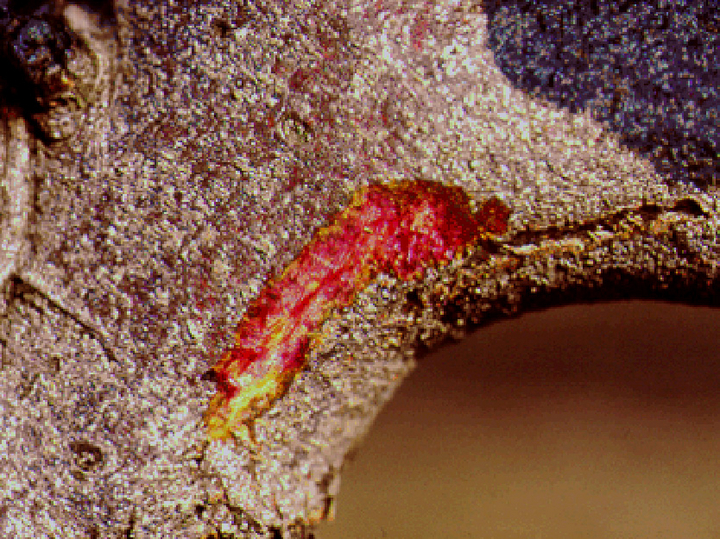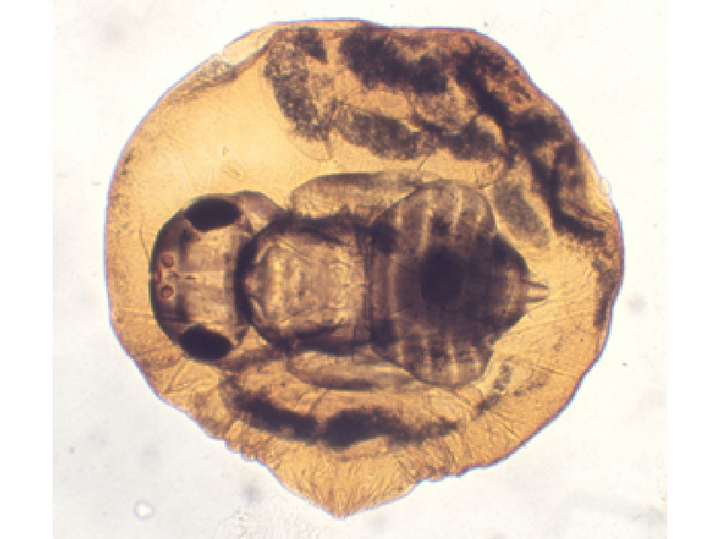San Jose scale
Comstockaspis perniciosa
Appearance

Among the scale insects (Coccoidea), the San José scale insect belongs to the lid scale insects (Diaspididae), which are characterized by the fact that a "lid" covers their body. The adult scale insects are lemon-yellow, sac-like structures and hide under scale covers. Unlike the plump, legless, and fixed-sitting females, males have segmented bodies with antennae, legs, and wings and can leave their lids.
The small, yellow-colored young larvae also live under shield covers, but are free to move.
Biology
The San José scale usually overwinters on the tree as an attached juvenile aphid (1st larval stage). By May, the larvae develop into sexually mature, immobile females or freely moving, winged males. The short-lived males seek out the females for mating. After about 30-40 days, the female gives birth to the young larvae in viviparity, up to 400 larvae in a period of six to eight weeks. The larvae (wandering larvae) are free to move and suckle near the mother. They form their own shield, where their development takes place in several larval stages - female scale insects go through two larval stages, while males go through four larval stages until they become sexually mature. Under favorable developmental conditions, they are ready to reproduce after 33 to 40 days. There are usually two generations per year, but in hot and dry years three generations are possible. The first larval run occurs around mid-June, the second at the end of August, and the possible third from mid-October.
As a plant sucker, the San José scale aphid has a piercing proboscis with which it bites into the bark and sucks out the cells.
Damage symptoms

The occurrence is characterized by the immobile scale on the bark of the infested woody plants. In the case of the San José scale insect, 1-2 mm large, circular or elongated, yellow-brown to black-grey scale covers are visible at the beginning.
Due to the rapid multiplication ability, densely connected crusts can already be seen on the bark within a short time, which can be scraped off in scales. In case of heavy infestation, the bark looks as if dusted with ash and becomes cracked in many places.
Adult scale insects hide under the scale covers. The small, yellow juvenile larvae are free-moving and can be found as bright spots at the infested areas from June to October. At this time, leaves and fruits are also infested, here mainly the calyx and stem cavity. The infestation is very conspicuous on light-barked fruit varieties, fruit and leaves, as a red halo develops around the attached scale insect.
Propagation and transmission
The San José scale insect is spread by the free-moving juvenile aphids, which search for suitable sites on the plant and can be passively carried by the wind. They can also cling to insects, birds or other animals and be spread by them (phoresy).
Much greater importance, however, is attached to spread by trade (over long distances), such as by carryover with infested nursery stock.
Prevention and control

Preventive measures
- Biological control: protection of natural enemies, especially the parasitic San José scale insect(Encarsia (= Prospaltella) perniciosi).
Direct measures
- Removal and destruction of heavily infested woody plants
- Winter and budburst treatments with budburst sprays during dormancy (budburst stage I) and from budburst to mouse ear stage (II - IV) (see list of plant protection products approved in Austria).
- Summer treatments at the time of larval run with plant protection products for the control of scale insects listed in the list of plant protection products approved in Austria.
Last updated: 31.10.2023
automatically translated